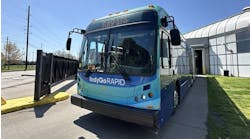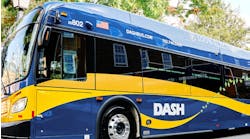Montgomery County Executive Isiah Leggett on June 2 announced that an eight-year bus stop improvement program has enhanced Americans with Disabilities Act (ADA) accessibility and pedestrian safety at 2,879 bus stops.
A survey of the County’s 5,400 stops completed in 2006 identified 3,400 in need of some type of improvement. Work continues to upgrade the remaining bus stops.
“Every bus passenger deserves a safe and accessible way to get to and from a bus stop and a safe and accessible place to wait for the bus,” said Leggett. “I’m proud of the progress we have made in improving nearly 3,000 bus stops for our transit riders, especially those who are disabled. We are using a holistic approach that looks at the bus stops, not in isolation, but as a key component in creating a safe travel pathway. Improving pedestrian safety has been a priority of my administration; transit passengers are pedestrians at each end of their trip. Where needed, we have also added sidewalks, safer pedestrian crossings, traffic calming measures, more lighting and road improvements to achieve our goal of creating a safer and more walkable community.”
Improvements to the bus stops have included construction of:
- 1,246 ramps at 813 intersections;
- 79,240 square feet of sidewalk leading to bus stops;
- 161,647 square feet of five-by-eight-foot concrete pads at 2,400 bus stops; and
- 408 “knee walls” at sloped sites to prevent wheelchairs from rolling onto dangerous terrain and provide seating for waiting passengers.
The bus stop survey inventoried each of the County’s 5,400 bus stops for 115 factors in five categories: precise location, accessibility, level of safety, information/signage and amenities. Upgrades were first made to stops with the highest ridership and those deemed of most urgent need of improvement, such as stops that were not located at intersections and required pedestrians to cross mid-block or were located alongside multi-lane roads with fast-moving traffic. Many bus stops were moved to safer locations. Once in a specific area, enhancements were also made to surrounding stops to improve construction cost efficiency.
In addition to ensuring ADA compliance, bus stop upgrades also reduce the distance to crosswalks, provide pedestrian refuge islands, establish connections to existing sidewalks, address slope issues and improve drainage.
The $11 million Bus Stop Improvement Project was approved in the 2006-2011 six-year Capital Improvements Program budget. As well as enhancing Ride On bus stops, the Montgomery County Department of Transportation (MCDOT) is also improving about 600 Washington Metropolitan Area Transit Authority (Metro) stops and 900 stops shared between Metro and Ride On located in Montgomery County. The average cost to improve each bus stop is $3,000.
MCDOT continues efforts to improve the remaining 500 bus stops. Upgrading these stops is more complex because many of the stops are located on roads not originally built to accommodate pedestrians. Enhancing these bus stops require purchasing right-of-way from private property owners or trying to work around obstructions, such as walls and fences, that prevent installing ADA compliant facilities.
Information about Ride On routes and schedules is available online.

